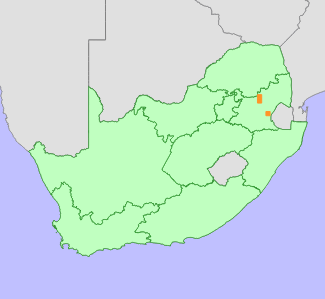|
Scientific Name | Riocreuxia aberrans R.A.Dyer |
Higher Classification | Dicotyledons |
Family | APOCYNACEAE |
Synonyms | Ceropegia brachysiphon H.Huber |
National Status |
Status and Criteria | Near Threatened D2 |
Assessment Date | 2012/05/10 |
Assessor(s) | M. Lötter, J.E. Burrows, J.E. Victor & L. von Staden |
Justification | A range-restricted (EOO 1645 km²), localized habitat specialist known from fewer than 10 locations and potentially threatened by habitat loss to development, mining and competition from alien invasive plants. |
Distribution |
Endemism | South African endemic |
Provincial distribution | Mpumalanga |
Range | Dullstroom to Ermelo. |
Habitat and Ecology |
Major system | Terrestrial |
Major habitats | Steenkampsberg Montane Grassland, KaNgwane Montane Grassland |
Description | Wedged in cracks among rocks on exposed quartzite ridges. |
Threats |
| Grasslands within the known range of this species are currently about 30% transformed, mainly for crop cultivation and timber plantations. Neither of these land uses however are likely to impact this species, as the shallow rocky soils where it grows are unsuitable for cultivation. Between Carolina and Amsterdam, large areas of grasslands are under plantations, but extensive rocky ridges and outcrops have been left undisturbed. At at least one location plants are potentially threatened by competition from alien invasive wattles in the area: alien plants often establish in rocky areas due to protection from grassland fires. Subpopulations are also potentially threatened by habitat destruction through quarrying and mining. Although no populations are currently threatened, large areas of Mpumalanga province have been granted mining or prospecting rights, and an increasing number of properties already have mining applications on them. In the Dullstroom area, development of leisure estates have increased in the past 10 years, and further development could potentially affect some subpopulations. |
Population |
A rare and localized species, restricted to a specialized habitat. Local abundance range from very small subpopulations of around 10 individuals to locally frequent in some places.
|
Population trend | Stable |
Assessment History |
Taxon assessed |
Status and Criteria |
Citation/Red List version | | Riocreuxia aberrans R.A.Dyer | NT D2 | Raimondo et al. (2009) | | Riocreuxia aberrans R.A.Dyer | Insufficiently Known | Hilton-Taylor (1996) | |
Bibliography |
Dyer, R.A. 1957. Riocreuxia aberrans. Flowering Plants of Africa 32(2):t. 1253.
Dyer, R.A. 1980. Brachystelma, Ceropegia and Riocreuxia. In: O.A. Leistner (ed). Flora of Southern Africa 27 Part 4:1-88. Botanical Research Institute, Pretoria.
Hilton-Taylor, C. 1996. Red data list of southern African plants. Strelitzia 4. South African National Botanical Institute, Pretoria.
Masinde, P.S. 2005. A revision of the African genus Riocreuxia Decne. (Apocynaceae:Asclepiadiodeae-Ceropegieae). Kew Bulletin 60(3):401-434.
Raimondo, D., von Staden, L., Foden, W., Victor, J.E., Helme, N.A., Turner, R.C., Kamundi, D.A. and Manyama, P.A. 2009. Red List of South African Plants. Strelitzia 25. South African National Biodiversity Institute, Pretoria.
|
Citation |
| Lötter, M., Burrows, J.E., Victor, J.E. & von Staden, L. 2012. Riocreuxia aberrans R.A.Dyer. National Assessment: Red List of South African Plants version 2024.1. Accessed on 2025/10/18 |
 Comment on this assessment
Comment on this assessment


